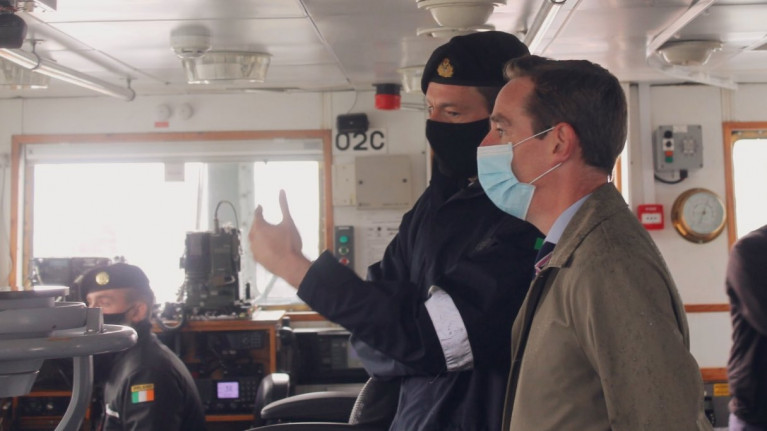Displaying items by tag: Ryan Tubridy
Ryan Tubridy was a guest of the Irish Naval Service yesterday having taken a private tour and coastal trip onboard LÉ Ciara from Dun Laoghaire Harbour into Dublin Bay before the onset of Storm Ellen, writes Jehan Ashmore.
The broadcaster of the Ryan Tubridy Show on RTE Radio 1, spoke on his programme this morning following his naval tour-trip, citing a limited knowledge of nautical terms. This was clearly demonstrated when boarding LÉ Ciara in Dun Laoghaire Harbour where he mentioned 'boat' but the crew corrected him with a reply of 'ship'.
Despite the introductory slip-up, Ryan was clearly impressed of the work involved in the Naval Service as crew of the LÉ Ciara gave him an insightful tour. This included the bridge, mess-room and the galley, where the menu is constantly changing, given the variety is all too important to keep a crew of 39 (including 5 Officers) content while working at sea.
Among the equipment highlighted on the bridge, was the satelitte tracking of ships represented by 'lights' as Tubridy refered to, however the distinct absence of such notably off the south-west coast was due to Storm Ellen, which kept fishing vessels decidely away from such dangerous seas.
It was during yesterday morning that Afloat routinely tracked online shipping, among them LÉ Ciara to Dun Laoghaire Harbour and by concidence this took place shortly before listening to the Tubridy Show discussing the pending invite from the Naval Service.
Prior to this, LÉ Ciara had sailed from Cork Harbour to Dun Laoghaire Harbour where the radio presenter (to grace TV screens in September with RTE's flagship 'Late Late Show') was taken out on a short coastal trip into Dublin Bay. This included a transit through Dalkey Sound which took place before noon which then led the Coastal Patrol Vessel (CPV) return to Dun Laoghaire Harbour having rounded Dalkey Island.
It was in these same waters where Afloat reported last week, a rockfall incident within Coliemore Harbour, Dalkey which forced the temporary closure of the passenger ferryboat service to the island 300m offshore. This remains so also given the tail end of Storm Ellen.
As for LÉ Ciara, the sleek CPV has been in the Naval Service for more than 30 years, following an initial career albeit brief of just 4 years with the UK Royal Navy's Hong Kong Patrol Squadron before its Irish role where the ship was not the only ship in Dun Laoghaire Harbour yesterday as outlined below.
Firstly though was the excursion vessel, St. Bridget of Dublin Bay Cruises that was berthed ahead of LÉ Ciara while routinely alongside St. Michael's Pier, though given the increasingly inclement weather not surprisingly no cruises took place among them around Dalkey Island. The bad weather led St. Bridget yesterday afternoon make a 'repositioning' short passage across Dublin Bay to take a berth in the capital port next to the tug, Giano as Afloat has also reported.
While back in Dun Laoghaire Harbour the homeport of ILV Granuaile which berthed at Carlisle Pier and where nearby the Commissioners of Irish Lights operate the tender from their headquarters located beside the port's marina. Asides leisure craft and yachts is the former Dutch barge Stella at the 'Coal' Harbour and a former UK based Thames lighter tug, Swiftstone which is undergoing restoration as a 'heritage' tug.
The UK connection continues as L.É. Ciara was formerly a Royal Navy vessel HMS Swallow stationed in the waters of Hong Kong as part of a coastal patrol squadron based at the former colony. The 62m vessel which has a shallow draft of 2.7m, was acquired by the Irish Government in 1988 and the CPV celebrated more than three decades in service as Afloat previously highlighted in recent years.
L.É. Ciara's primary armament consists of a 76mm OTO Melara compact gun mounted at the fo'c'sle near the bow in addition a Canon Radamec Fire Control System. As for service speed is given as 25 knots but can be more.
Following the media-naval rendez-vous, Afloat observed the L.É. Ciara re-enter Dublin Bay yesterday as the CPV at almost 14.15 was offshore of The Muglins where a lightbeacon is located on the rocky islet to the east of Dalkey Island. For more on local coastal matters, see: 'Maritime' Dalkey series (2011-2016) published in the Dalkey Community Council Newsletters.
According to online tracking, L.É. Ciara headed back to its homeport of Cork Harbour as Storm Ellen progressed, though the CPV arrived just before 2300hrs last night where the small ship remains at anchorage.




























































